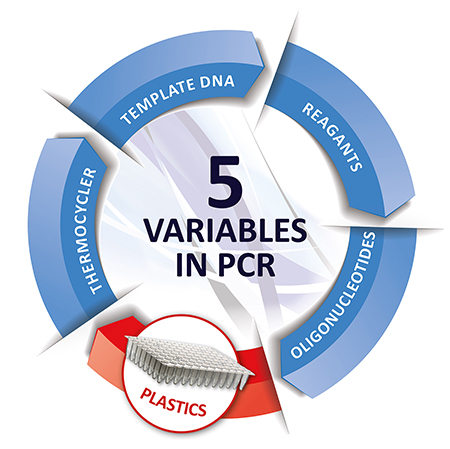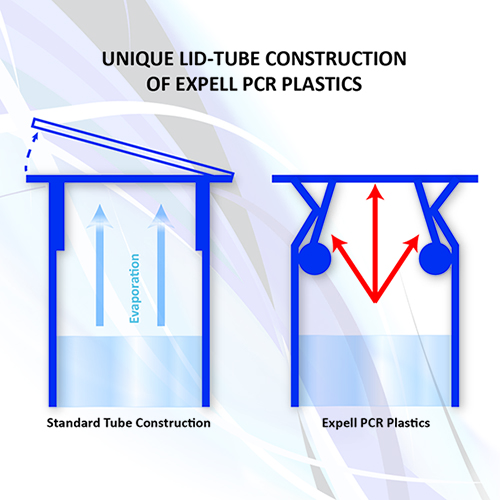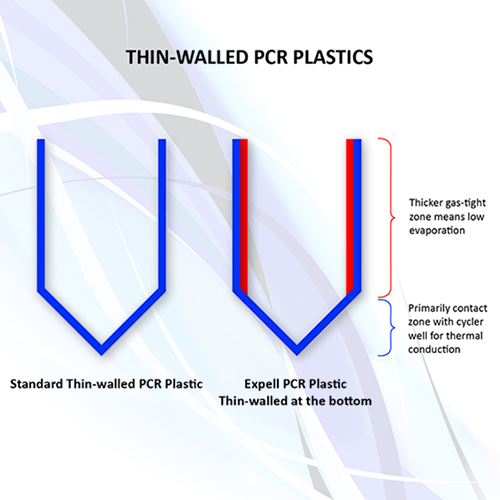PCR protocol
Are you in control of your PCR protocol?
… or does it work one day but not the other? Being in control of your PCR protocol means obtaining results you can rely on.
Results, that are reproducible and accurate.
Establishing your PCR protocol – 5 crucial variables
When preparing your PCR protocol, you usually focus on the template DNA, reaction mix (buffer, dNTPs, taq polymerase), primers, probes and your thermocycler, as the main instrument to carry the reaction on.
What you probably do not focus that much on are the plastics – plates, strips or tubes to process the samples in.
Plastic is just a commodity, so what difference does it make?

The outcome of your PCR protocol
As an accredited lab you take the full responsibility for the quality of your results. A mistake could have fatal consequences either for the single patient, for a bigger population or for your own reputation as such.
This article will help you to understand the impact of PCR plastics on the reproducibility and accuracy of your PCR protocol.
Controlling your PCR protocol #1: The variable of Plastic
There are two basic parameters to measure the impact of the Plastic on your PCR protocol:
- the accuracy – which is the average temperature obtained on the whole thermocycler block; and
- the uniformity, which is the difference between the hottest and the coldest well on the plate.
Let’s have a look at how do the Plastics influence your PCR protocol?
Controlling your PCR protocol #2: Full DNA-sample recovery
The feature of highly polished, non-binding inner surface is often highlighted on the market, but PCR is not about recovering the full amount of the liquid included in the sample. It is the full recovery of the DNA that counts on your PCR protocol!
Expell PCR Plastics are anti-static. How does it affect the DNA sample recovery?
Both dNTPs and DNA are negatively charged and the majority of the plastics on the market are positively charged.
In result, the commonly used plastics will retain the elements of the probe.
Expell PCR Plastics are zero-charged, ensuring maximal sample recovery, as the biomolecules are not ‘sticking’ to the plastic walls of the tube.
Controlling your PCR protocol #3: Closure of the tubes
Most PCR Plastics have a standard lid closure with straight edges of the lid being pressed into the straight walls of the tube.
This type of closure requires more pressure, resulting in ‘painful fingers’, especially if the closure-opening operation is repeated intensively during the working day.
The lid-tube edges of Expell PCR Plastics are bent. This unique and innovative cap-tube design ensures convenient soft closure and opening, keeping the tube 100% leak-proof through the whole PCR protocol. No more ‘painful fingers’ by opening and closing of the tubes!

Controlling your PCR protocol #4: Softness and flexibility of the Plastic
There are multiple types of PP (polypropylene) blends used for PCR Plastics production. The type of the plastic used will affect the work comfort (open-close operation), the fitment of the plastic into the thermocycler block as well as the durability of the plastic.
Many commonly used PCR Plastics crack upon the PCR protocol.
The unique blend of PP (polypropylene) used on Expell PCR Plastics makes them easier to use and prevent them from cracking upon temperature change.
Controlling your PCR protocol #5: Evaporation and thermal conductivity
Thin-wall plastics tend to be associated with a better thermal conductivity, which is also true, though to some extent. The crucial question here is which part of the tube has thin walls? Are the sidewalls of the tube thin or is it the bottom of the tube, having contact with the well of the thermocycler block?
PP is not a gas-tight material, therefore the thicker the sidewall of the tube is, the less gas will come out.
The thermal conduction occurs at the bottom of the tube, where the tube has physical contact with the block well, transferring the heat.
Expell PCR Plastics are thin in the bottom and thicker on the sidewalls, enabling ultimate heat conduction and which combined with the innovative lid closure reduces the evaporation rate to 5% only!

Controlling your PCR protocol #6: Thermocycler fitment
When choosing your PCR plastic pay attention to the height of the tube, i.e. fast PCR or qPCR thermocyclers work best with low profile tubes of 15.6-16.6 mm. Standard PCR/qPCR cyclers will operate with regular profile tubes of 20.9-21.8 mm. If you use a regular profile tube on a fast cycler, the tube will be mashed.
Expell PCR Plastics provide universal portfolio, which is compatible with the majority of cyclers used on the market. Contact us to find the right Plastic for your set-up.

